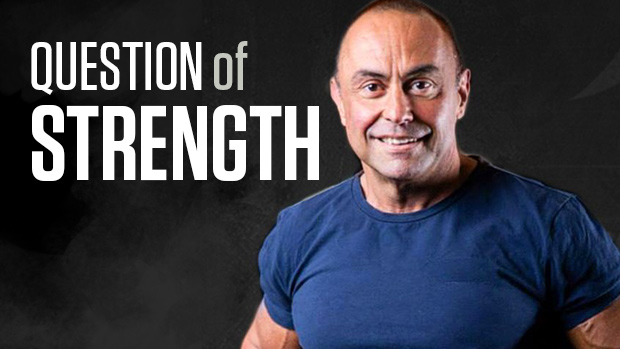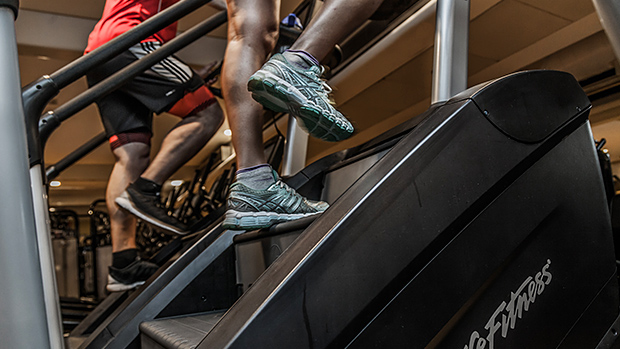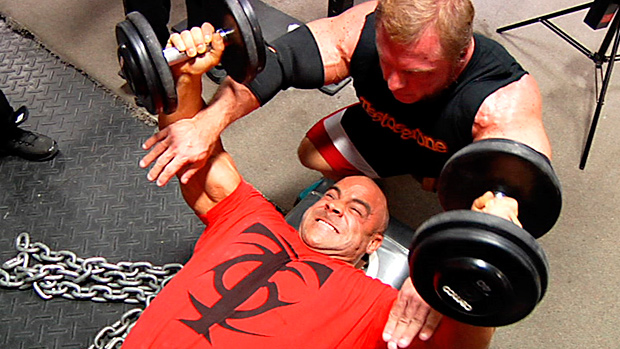Q: When training twice a day, can you train only one muscle group for that day or can you train two, such as a pair of antagonists like chest and back?
A: Well, I think that one can grow more if they have the luxury of training twice a day. However, most of us have career and family commitments that prevent us from employing such an extensive training schedule.
Working out twice a day can be very effective, provided that you pay respect to the following principles:
- Keep the workouts short. Excluding warm-up time, your workouts should be no more than 40 minutes in length. Training longer than that would be counterproductive.
- Use the proper training sequences. In my opinion, the same body part should be trained twice on the same day. Here are a variety of options:
Option A
- Morning: Heavy
- Evening: Light
From experience, I have found that working heavy in the morning and doing higher reps at night works quite well. For example, do sets of 4-6 reps in the morning and sets of 12-15 at night.
Option B
- Morning: Low reps, fast tempo
- Evening: Low reps, slow tempo
You could also use the same rep brackets during both workouts but with a different tempo. For example, do 4-6 reps on a 30X tempo in the morning, and 5-7 reps on a 505 tempo at night.
Option C
- Morning: Heavy
- Evening: Eccentric-only
Another one I like is training heavy in the morning and doing eccentric-only training at night. For example, heavy front squats 6x2-3 on a 501 tempo in the morning; and eccentric back squats of 7x1 on a 1001 (10-0-1) tempo at night. To help me do this type of workout, I use the eccentric hooks known as Power Recruits.
Editor's Note: Power Recruits allow you to hook extra weight on the bar, but when the additional weights come into contact with the ground, they jettison, thereby lessening the resistance and allowing you to do the concentric part of the lift. Call Bob Kowalski at 814-378-7108 for more information.
Regarding exercise selection for both workouts, you may want to do the same ones morning and night if strength is your main concern. However, if hypertrophy is your goal, you may want to use different exercises. For example, weightlifters will do back squats twice a day, while a bodybuilder may do bench presses in the morning and incline dumbbell presses in the afternoon.
- Pay close attention to post-workout nutrition. Liquid nutrition is best. For a 200-pound bodybuilder, I recommend a shake containing 40-50 grams of protein and an appropriate number of carbs. Here's my updated formula for post workout carb intake:
- 1.0 gram of carbs per kg of bodyweight if total reps per workout is 80 reps or less (relative-strength workout)
- 1.5 grams of carbs per kg of bodyweight if total reps per workout is around 250 reps (25 sets of 10 reps)
- 2.0 grams of carbs per kg of bodyweight if total reps per workout is 400 reps or more (30 sets of 15 RM)
Obviously, simple math will allow you to figure out how many reps you did and what your total volume of training was for that day.
When training twice a day, I suggest you take a very good anti-oxidant formula and an extra 10 grams of vitamin C each day. If you can afford it, take a phosphatidyl serine supplement (800 mg) after the second workout of the day. I've found that PS helps you have a better testosterone:cortisol ratio. I've also found that taking alpha-lipoic acid post-workouts with your shake helps reload the energy substrates more quickly.
- You must leave 4-6 hours between workouts. This time spread is critical. If you use a shorter one, you will be too fatigued.
- For every two weeks of twice-a-day training, do one week of once-a-day training. This will insure that you will not overtrain. It has been shown that training twice a day for short periods may depress testosterone temporarily. However, the testosterone will shoot right back up if you cut back to once-a day-training for a week.
Good luck!
Q: Should there be any modifications to training routines for those of us who are tall (6'5")? I weigh 200 pounds and seem to be stuck at this weight. After moving up from 170 as a result of one year of training, I've been stalled at 200 for about a year now. I am 38 years old. Training is as follows:
- Day 1: Chest, shoulders, triceps
- Day 2: Back, biceps
- Day 3: Off
- Day 4: Legs (yes, I squat)
- Day 5: Off
A: Height has nothing to do with loading parameters, but athletes who rank higher on the ponderal index (weight divided by height) tend to need longer rest intervals between sets and training days.
The mistake you are making is overtraining your upper body. Put your leg workout in between the two upper body days.
Q: Just a little "question of strength" that I thought you could answer. A couple of days ago, I hit the gym without my brother (training partner/spotter) on chest day, so I thought I'd try out the Smith machine just for a change of pace. By using the SM, I found that I could increase the weight by almost 40 pounds for the same amount of reps. What gives?
My guess is that the SM takes my stabilizers out of the movement, allowing me to use more weight. I also found I got a much better pump with the increased poundage, compared to regular benching.
A: The reason you can do 40 pounds more is that most Smith machines are counterweighted, and that takes away some of the load. You're also right about the stabilizers—you've taken them out of the picture, and that allows you to use more weight.
However, if you keep using the Smith machine, you'll increase the odds that you'll incur a shoulder injury. Habitual use of the Smith machine forces the muscles to experience something called "pattern overload syndrome." In other words, it forces the muscles, tendons, and ligaments involved to work in the same pattern, over and over again, greatly increasing the chances of injury. Overuse of the Smith machine is discouraged for other reasons, too. Consult my book "The Poliquin Principles" for more information. It's available at Barnes and Noble and Borders bookstores.
Q: Is there anything I could add to Power Drive to make it even more effective? I make a good living, so money isn't an issue.
A: I would say that your best bet is to add phosphatidylserine to your stack. This phospholipid molecule, when combined with Power Drive, will take your concentration levels to new heights and will also blunt exercise-associated increases in the catabolic hormone know as cortisol. Phosphatidylserine may, therefore, not only help improve your ability to focus during a workout, but also help you accelerate recovery rate and minimize the risks of overtraining. It is Dr. Serrano's and my opinion that the optimal pre-workout dosage for phosphatidylserine appears to be between 800 and 1,200 mg.
You should only use phosphatidylserine on days that you work out. Using large amounts of phosphatidylserine on a daily basis will suppress cortisol levels to a point that's too low. This can lead to various medical problems ranging from severe joint pain to even more serious medical conditions.
I have recently stumbled upon a very good brand of PS at a decent price. There's a pharmacist in Dallas named C.D. Parks who makes supplement combos to order. He made me 150-mg capsules of PS, using cinnamon as the filler. I take six capsules along with one serving of Power Drive 45 minutes before I work out.
If you're interested, he'll make you a similar supplement, or make any modifications you desire. To contact C.D., email him at cdparks@airmail.net or call him at 1-888-481-8711 or 214-871-8711.
Q: I have a friend who is a strength coach at a university. While sitting in on an in-season training session with the football team, I noticed that they weren't controlling the eccentric movement of the bench press. We then got into a discussion on tempo principles. My friend claimed that he observed a high incidence of shoulder pain (which mimics biceps tendonitis) when he had the players slow down the bench press. Does this make sense? What would be the cause or causes?
A: You might want to use the Jack Nicholson line from the movie "A Few Good Men" with your friend: "The truth? You can't handle the truth!!!"
No, no, no. There is no way that slowing down the eccentric portion of the lift can mimic bicipital tendonitis symptoms. His players are pissing on his leg and telling him it's raining. In other words, they can't bench press any appreciable weight unless they use their pecs as a launching board.
The best powerlifters in the world for the bench press have been found to lower the bar slower than their lesser-ranked colleagues. For a great analysis of bench press technique, read "Bench Press More, Now" from biomechanics expert Tom McLaughlin. This is available from the Crain's Muscle World website.
Q: I can't seem to keep track of my completed repetitions during the middle of my sets. I'm concentrating on using the proper tempo, especially when the eccentric portion is over four seconds long and my time-under-tension exceeds 40 seconds. Any tips would be appreciated!
A: Have you got a serious case of repetition obsessive compulsive disorder? Are you afraid of stepping on sidewalks? Do you lock and relock your door 52 times before going to bed? Do you wash your hands between sets?
Relax! In essence, you are placing form over substance.
Why do you think most powerlifters don't do more than five reps per set? Because most of them can't count to six! Yet, they get great results. Likewise, rugby players need to drop their pants if they want count to eleven.
Double your gingko biloba intake by taking a double dosage of Power Drive.





